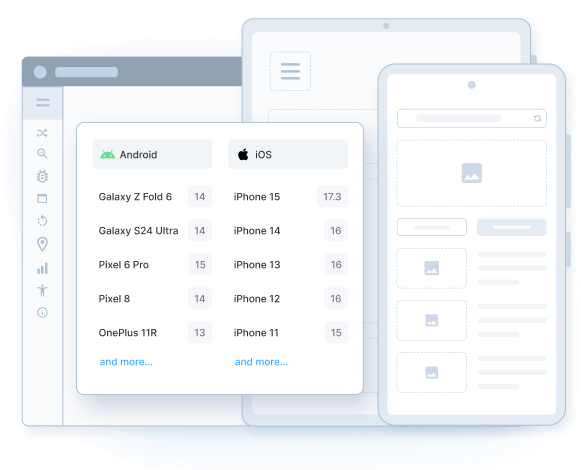Mobile Device Testing
Instant access to a varied range of mobile devices for testing on the cloud.
Our mobile devices are constantly updated with the latest and best of Android and iOS devices, like Samsung Galaxy, iPhone, Pixel, etc.

Trusted by more than 50,000 customers globally
Benefits
Replace your device labs
Mobile devices are available for everyone, all the time, without any setup. View all mobile features
Responsive mobile device testing
Check your site across device sizes, viewports and resolutions. Test now.
Instant Access to Real Devices
No queues for testing. Pick a mobile device and start testing. List of devices to test on.
Frequently Asked Questions
Mobile device testing, as the name suggests, refers to the testing of web or mobile applications across a wide range of real mobile devices. This form of testing can also be carried out from a hardware testing standpoint to validate the functionality of specific features.
Testing websites and applications on real mobile devices help validate their functionality, consistency, and robustness across Android and iOS handsets. Moreover, it’s extremely critical to ensure that websites are mobile-friendly across devices. A non-responsive website may lead to a disappointing user experience and consequently may result in loss of potential revenue from customers.
Testing web apps across real mobile devices help identify and resolve such visual issues and deliver consistent user experiences for all mobile users.
Mobile device users have surpassed the number of desktop users and mobile devices account for more than half of overall web traffic. This clearly indicates a massive increase in the adoption of mobile devices. Let’s take a look at some key mobile statistics that make this point:
- The number of smartphone users worldwide is expected to hit more than 3.8 billion by the end of 2021.
- Millennials spend more than 5 hours on their smartphones per day.
- 53% of online shopping traffic comes from mobile phones.
Considering the above numbers, one can conclude how mobile phone usage has grown exponentially. Additionally, there are 9000+ distinct devices in global usage. Naturally, to ensure a consistent user experience for most mobile users, mobile device testing is unavoidable.
Mobile device testing can be either performed manually or by using an automation testing tool like Appium. At a high-level, follow the steps below to get started with mobile device testing:
- Identify the scope and coverage of tests that need to be covered.
- Decide the geographies for which the app needs to be tested (localization).
- Determine device coverage based on the target audience research.
- Strategize the test process (categorize manual and automated tests).
- Create test cases.
- Execute tests on emulators or real devices.
- Monitor the performance and track bugs if any.
Refer to this detailed guide on how to test mobile applications manually for a better understanding of mobile device testing.
Emulators or simulators are software programs that simply mimic the functionality of a real device. These programs involve binary translation and are slow as compared to real device testing.
QAs need to determine the number of devices their app must be tested on and accordingly download emulators for each device. Downloading and testing on an Android emulator or iOS simulator is a very effort-intensive and inefficient task. Teams can’t afford to adopt such an approach, especially in such a competitive online landscape.
Testing apps on real mobile devices is the best way to yield accurate test results as it evaluates app performance on a real device by putting it through real user conditions. This also fosters faster detection and resolution of critical bugs that may pop up in the production environment.
Refer to this article on why virtual machine testing is inadequate for mobile device testing.
BrowserStack’s real device cloud provides QA teams with 3000+ real devices and browsers for on-demand remote testing. One can choose from an extensive range of latest and legacy handsets launched by popular vendors like Apple, Samsung, Oneplus. Pixel, etc for instant website or app testing. This means that teams don’t need to worry about maintaining any on-premise device lab. One can straight away get started by signing up for a free trial.
Moreover, BrowserStack also offers integrations with popular test automation frameworks like Appium, Selenium, Espresso, XCUITest, etc to facilitate easy, fast, and comprehensive test cycles. The device cloud is frequently updated with the latest devices, so one can monitor software on devices customers are most likely to use.
